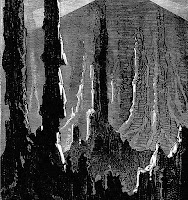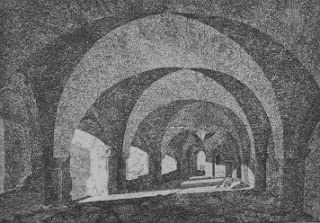Rewind to the 2000s. I'm in college, the OSR is (unbeknownst yet to me) just
beginning to take shape, and the world is a mildly younger place - one in
which Netflix still sends you DVDs in the mail instead of streaming its own
original content. The fortunate we - that is, my house-mates and I: one knew
how to cook, one had a Netflix account, and I had a working vehicle; by our
powers combined, I'm told, forming a functioning adult - were to receive one
such DVD to watch around the old idiot box together. Admittedly, we might have
ordered the
Mystery Science Theater 3000 version, but the film about which I'm talking - the sword and sorcery "classic,"
Hawk the Slayer.
N-Spiration: Hawn the Slayer
About the Film
Originally intended as a historical fiction, 1980's Hawk the Slayer is
the brain child of Terry Marcel and Harry Robertson - who, after learning of
their shared affinity for the Sword & Sorcery genre, added the title
character, Hawk's, magical sword - and from there, the story evolved into an
inescapably fantasy experience. Be it the Elf, "Giant", or Dwarf who accompany
Hawk on his mission, the witch that he uses to re-unite them and who assists
the party in their mission, or the central conflict - a brother's envy over a
mystic imbued sword - this movie is quintessentially a D&D experience: as
a party of adventurers use their might and their wits to navigate through a
semi-episodic series of events, culminating in a cohesive narrative and
cinematic climax.
For those interested in seeing Hawk the Slayer, it's available to stream online:
- Tubi (with ads)
- VRV (with ads)
- ShoutFactory
-
...or the
IMDb TV App
(with ads, where I watched it to inspire this article)
It's likewise available on DVD or VHS for those interested enough to search it
out.
Why Hawk?
First and foremost, to be clear, Hawk the Slayer is not what one would call a "good" movie. This might come as somewhat of a surprise considering the casting and participation of Jack Palance, perennially acclaimed and recipient of decades of cinematic awards and accolades. However - for those with a taste for the hokey - Hawk the Slayer delivers a fun experience with its low-budget camera "techniques" (reversing footage of a thrown object to simulate telekinesis; at least one entire fight sequence shot in slow motion; cutting back and re-playing firing sequences to present rapid-fire archery; ...), its 70's classic soundboard (an Elfish accent reminiscent of 2-XL; sorcery signaled by synthesizers; ...), and its somewhat cardboard-cutout characters, and character motivations. The film is rated PG despite a body count, according to IMDb, of 116 - making it a fairly good fit for a younger audience: one too young to start asking too many questions or drawing too many conclusions based on better produced or better written franchises.
So, if it's a bad movie, why are you recommending I watch it? I didn't
say it was a bad movie - only a movie that falls into what I lovingly refer to
as the Mystery Science Theater Category. Its a film that comes off as
unintentionally funny and makes a good inebriated romp with your friends and,
on top of that, may serve to inspire encounters and scenes for a
beer-and-pretzels game.
To speak to the merits of the film for the budding OSR player or referee, Hawk the Slayer has two main elements going for it - the first of which being party dynamics. The core group supporting Hawk in his quest consists of two ranged fighters - the bow-master Elf and the crossbowman (with a rapid fire crossbow: but we're beyond the point where I poke fun at the film's B-movie qualities) - and two melee fighters: Hawk, himself, and Gort, the Giant. The Dwarf, Baldin, fills the role of quintessential Thief - being aware of his own stature, he takes advantage where he can - hiding, ducking, flanking, and I believe engaging both at range and in melee. This is important, as it recognizes his core competency is outside the brawl. Further, a sixth party member - a sorceress (read, Magic User) - helps outside of combat by teleporting party members, by divining the location of sought foes or other elements, and similar magic. But don't M-Us throw fireballs in real D&D? Yes - they do - but the sorceress is important for a couple reasons: first, she doesn't fight in combat! The Magic User knows her limits and avoids battle. Second, not all magic users have the flashy spells - in procedurally stocked dungeons, there is no guarantee you will find the flashy spells you're looking for, and more so, it highlights that other spells: read, the divination in particular - can be more useful. If your party knows what to expect when going into an adventure - if they have scouted the location safely via a scrying pool - they are going to encounter a lot more success, know to bring the right equipment, and anticipate challenges that they can then plan to overcome. Player. Skill.
Finally and furthermore (and, warning, a spoiler is to follow: if you have not seen the movie and have been inspired to see the movie due to this glowing review, skip to the next heading) Hawk the Slayer offers an interesting perspective relevant to some modern OSR experiences: life without a Cleric. While the sorceress is helpful and essential - as discussed above - there is no divine magic, to my knowledge, in the film. There is an Abbess and nuns, holy women, but they are either all 1st level or equivalent limitation because there is no divine magic - no miracles - in the film. The residents of the abbey are helpful (and a hindrance) in their own regards, but nothing to the extent of the "Call healing from the heavens!" that we've come to expect of the Cleric archetype. In the final battle - when the Elf is injured - he afterward must stay with them, bed-rest, in order to heal while other survivors go on to further adventure. (Strict time records, anyone?)
And why I say this is relevant to the contemporary OSR is twofold: in the
blogosphere/podcast ecosystem, there has been some talk about the removal of
Clerics - the Lamentations second edition playtest/preview famously removed
Clerics as they did not fit the intended esthetic of the game; and secondly -
what happens if you just don't roll a good Wisdom between the four of you at
the table? You obviously can play a low Wisdom Cleric: old school editions of
the game don't preclude spellcasting (though they reward a high prime
requisite), one of the key elements of old school play is to think on your
feet.
 While some party compositions can make encounters of different types easier or
harder, the biggest impact they have is how you approach the problem. A
group that's heavy on Fighters will have a different approach to a dungeon
than one that's heavy on Thieves or Magic Users: the balanced party, though
helpful, is not mandatory like it is in more modern games: and
Hawk the Slayer illustrates this by showing how a party comprised of
Fighting Men and Rangers would approach the problem: making use of what he
has: a lesson aspiring OSR players would be apt to learn.
While some party compositions can make encounters of different types easier or
harder, the biggest impact they have is how you approach the problem. A
group that's heavy on Fighters will have a different approach to a dungeon
than one that's heavy on Thieves or Magic Users: the balanced party, though
helpful, is not mandatory like it is in more modern games: and
Hawk the Slayer illustrates this by showing how a party comprised of
Fighting Men and Rangers would approach the problem: making use of what he
has: a lesson aspiring OSR players would be apt to learn.
For Further Consumption
Not much, sadly.
In 1980, following the film's release, the director - Terry Marcel - was
excited enough to be planning a sequel, Hawk the Destroyer, however -
as far as I am aware - the sequel never materialized. Further, in 2015,
another product, Hawk the Hunter, was attempted on Kickstarter, but met
with failure. The Mystery Science Theater version that I alluded to was made
in 2014 in the guise of RiffTrax (so, same voices, but different IP) - which
is well worth the investment; but, in that
half
the
leads
have died, it may be a challenge for the creators to stoke the old flame on
celluloid.
That said - as of this year (2022) - Judge Dredd Megazine in its January
through April editions,
contains a sequel story to Hawk the Slayer in comic form. I have not picked up a copy - physical or virtual - of the issues available
to date: as such, I can't comment to their quality or applicability to the
gaming mind. If you, dead reader, were to be interested in them - however - I
wouldn't fault you for looking them up - and I wouldn't discourage you from
letting me know how they read to help me and other readers in our
determinations, as well!
In Conclusion
Having revisited the film, researched some on the side, and given detailed consideration - the Garimeter reading for Hawk the Slayer as it pertains to inspire your OSR campaign is 2.
Hawk is sword and sorcery to the bone and hits multiple tropes and expectations within the genre. Additionally, it's set in a faux medieval milieu that would make a fair match for many traditional home brew and published settings, alike. However, the quality of the over-all production - the writing, the cinematography, the acting: the film viewed holistically - is firmly likewise a cult film, a B-movie, and as such, is not for everyone. I have watched it - multiple times - and I have enjoyed it: so, if you, like me, enjoy both old school fantasy adventure and B-tier cinematic experiences, this film is for you.
Delve on, readers!
Hawk the Slayer and all imagery thereof is property of ITC Entertainment and is included in this article for review purposes under US Code Title 17, Chapter 107.
Advanced Dungeons & Dragons and all imagery related to Advanced Dungeons & Dragons is property of Wizards of the Coast and is likewise referenced and used under US Code Title 17, Chapter 107 as a combination of review and parody.
The slide-in of Gary... I got from a meme.
















